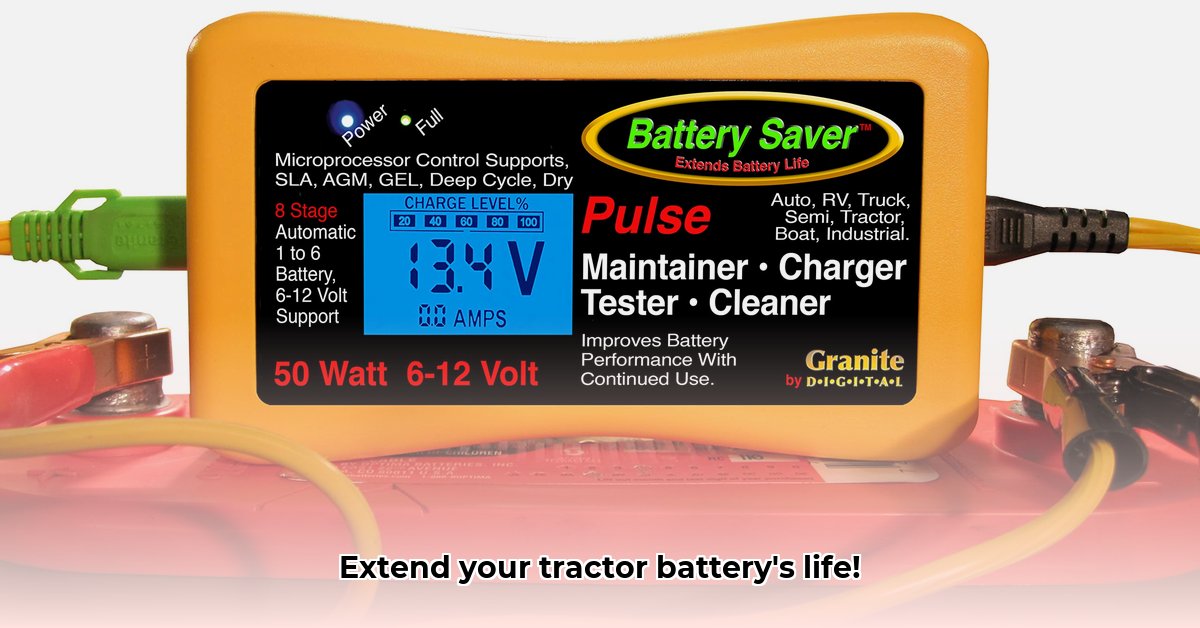
Keeping your tractor running smoothly is crucial for efficient and sustainable farming. A reliable 12-volt battery is the engine's heart, directly impacting productivity and environmental responsibility. This guide explores battery types, maintenance, disposal, and the overall environmental and economic impacts, empowering you to make informed decisions. For more information on 12V tractor batteries, check out this helpful resource: 12V Tractor Batteries.
Choosing the Right Tractor Battery: A Comparison of Options
Selecting the right battery significantly impacts your farm's sustainability and operational costs. Three main types exist: lead-acid, Absorbent Glass Mat (AGM), and lithium-ion.
Lead-Acid Batteries: These are the traditional choice, known for their affordability and widespread availability. However, they have shorter lifespans than other options, leading to frequent replacements and higher long-term costs. Furthermore, they contain lead, a heavy metal that poses environmental concerns if not disposed of properly. Are the short-term cost savings worth the environmental and long-term financial consequences?
AGM Batteries: Building on lead-acid technology, AGM batteries incorporate an absorbent glass mat, improving durability and vibration resistance crucial for farm equipment. They offer longer lifespans than standard lead-acid batteries, but still contain lead and require responsible disposal. While more expensive initially, is the extended lifespan justified by the increased upfront cost?
Lithium-ion Batteries: These advanced batteries boast the longest lifespans, lightweight designs, and superior performance. While the initial cost is significantly higher, the reduced need for replacements often results in substantial long-term savings. However, their manufacturing requires considerable energy, and responsible recycling is essential. The high initial investment presents a hurdle; are the long-term environmental and economic benefits sufficient to outweigh this?
The optimal choice depends on your budget, farming intensity, environmental priorities, and farm size. A thorough total cost of ownership (TCO) analysis is recommended before committing to a particular battery type.
Extending Your Tractor Battery's Life: Practical Maintenance Tips
Regular maintenance significantly extends battery lifespan and minimizes costly replacements. Follow these steps:
Clean Battery Terminals Regularly: Corrosion hinders electrical contact. Clean terminals with a wire brush and baking soda solution to ensure optimal performance. This simple step can prevent significant issues.
Implement Smart Charging Practices: Avoid repeated deep discharges. Utilize a smart charger that regulates charging, preventing overcharging and extending battery life.
Employ Proper Storage Techniques: Store the battery in a cool, dry place when not in use, preferably at approximately 50% charge to minimize self-discharge.
Monitor Your Battery's Condition: Regularly check voltage with a multimeter and visually inspect for cracks, leaks, or bulging. Early detection prevents costly repairs.
These practices collectively enhance battery longevity and reduce downtime.
Sustainable Battery Disposal: Minimizing Environmental Impact
Improper battery disposal harms the environment. Always recycle your spent batteries. Local auto parts stores, retailers, or waste management authorities can offer recycling options. Many facilities are equipped to reclaim valuable materials and some even provide incentives. Responsible disposal is crucial in minimizing the environmental impact of farming.
Environmental Impact Across the Battery Life Cycle
The environmental impact extends beyond disposal. Each battery type has environmental implications throughout its lifecycle – from raw material extraction to manufacturing and disposal. Lead-acid batteries contribute substantially due to lead mining and potential water contamination. While AGM batteries slightly reduce this impact, they still require responsible disposal. Lithium-ion batteries, although offering a longer lifespan, have an energy-intensive manufacturing process, requiring careful assessment of the overall ecological tradeoff. Ongoing research continuously improves the sustainability of battery production and disposal.
Total Cost of Ownership (TCO): A Long-Term Perspective
Beyond the initial price, consider the TCO. A cheaper battery requiring frequent replacements might cost more in the long run than a premium, longer-lasting model. Account for replacement costs, downtime, and labor when making your decision. A well-informed TCO calculation ensures both environmental and financial sustainability.
Conclusion: Making Informed Choices for Sustainable Farming
Choosing the right battery is a complex decision involving economic, environmental, and operational factors. This guide provides the information needed for informed decision-making. By understanding battery types, maintaining your batteries effectively, and disposing of them responsibly, you contribute to both the financial and environmental sustainability of your farm.
Key Takeaways:
- Regular battery maintenance is crucial for extending lifespan and reducing environmental impact.
- Choosing the right battery type for your farm's needs impacts both cost and sustainability.
- Proper charging and storage practices significantly improve battery longevity.
- Responsible battery recycling minimizes environmental harm.
- Understanding the total cost of ownership helps in making informed financial decisions.